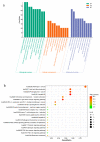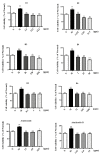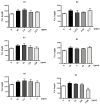Uncovering the Anti-Angiogenic Mechanisms of Centella asiatica via Network Pharmacology and Experimental Validation
- PMID: 38257275
- PMCID: PMC10821292
- DOI: 10.3390/molecules29020362
Uncovering the Anti-Angiogenic Mechanisms of Centella asiatica via Network Pharmacology and Experimental Validation
Abstract
Background: Centella asiatica (CA) has been used to address cancer for centuries in traditional Chinese medicine (TCM). Previous studies demonstrated its anti-angiogenesis efficacy, but the underlying mechanism of its action remains to be further clarified. This study aims to investigate the underlying mechanisms of CA and its triterpenes in anti-angiogenesis for cancer therapeutics through network pharmacology and experimental validation.
Methods: Cytoscape was used to construct a network of compound-disease targets and protein-protein interactions (PPIs) from which core targets were identified. GO and KEGG analyses were performed using Metascape, and the AutoDock-Vina program was used to realize molecular docking for further verification. Then, VEGF165 was employed to establish an induced angiogenesis model. The anti-angiogenic effects of CA were evaluated through assays measuring cell proliferation, migration, and tubular structure formation.
Results: Twenty-five active ingredients in CA had potential targets for anti-angiogenesis including madecassoside, asiaticoside, madecassic acid, asiatic acid, and asiaticoside B. In total, 138 potential targets for CA were identified, with 19 core targets, including STAT3, SRC, MAPK1, and AKT1. A KEGG analysis showed that CA is implicated in cancer-related pathways, specifically PD-1 and AGE-RAGE. Molecular docking verified that the active components of CA have good binding energy with the first four important targets of angiogenesis. In experimental validation, the extracts and triterpenes of CA improved VEGF165-induced angiogenesis by reducing the proliferation, migration, and tube formation of human umbilical vein endothelial cells (HUVECs).
Conclusions: Our results initially demonstrate the effective components and great anti-angiogenic activity of CA. Evidence of the satisfactory anti-angiogenic action of the extracts and triterpenes from CA was verified, suggesting CA's significant potential as a prospective agent for the therapy of cancer.
Keywords: Centella asiatica; anti-angiogenesis; cancer; network pharmacology; triterpene.
Conflict of interest statement
Authors Yang Yang, Qianghua Quan, Quan An were employed by the company Yunnan Baiyao Group Shanghai Science & Technology Co., Ltd. and East Asia Skin Health Research Center. The remaining authors declare that the research was conducted in the absence of any commercial or financial relationships that could be construed as a potential conflict of interest.
Figures












Similar articles
-
Combining In Silico and In Vitro Studies to Evaluate the Acetylcholinesterase Inhibitory Profile of Different Accessions and the Biomarker Triterpenes of Centella asiatica.Molecules. 2020 Jul 24;25(15):3353. doi: 10.3390/molecules25153353. Molecules. 2020. PMID: 32721993 Free PMC article.
-
Quercetin mediates the therapeutic effect of Centella asiatica on psoriasis by regulating STAT3 phosphorylation to inhibit the IL-23/IL-17A axis.Nan Fang Yi Ke Da Xue Xue Bao. 2025 Jan 20;45(1):90-99. doi: 10.12122/j.issn.1673-4254.2025.01.12. Nan Fang Yi Ke Da Xue Xue Bao. 2025. PMID: 39819717 Free PMC article. Chinese, English.
-
Wumei Wan attenuates angiogenesis and inflammation by modulating RAGE signaling pathway in IBD: Network pharmacology analysis and experimental evidence.Phytomedicine. 2023 Mar;111:154658. doi: 10.1016/j.phymed.2023.154658. Epub 2023 Jan 12. Phytomedicine. 2023. PMID: 36706698
-
Cardiovascular Protective Effects of Centella asiatica and Its Triterpenes: A Review.Planta Med. 2019 Nov;85(16):1203-1215. doi: 10.1055/a-1008-6138. Epub 2019 Sep 20. Planta Med. 2019. PMID: 31539918 Review.
-
A review of pharmacokinetic and pharmacological properties of asiaticoside, a major active constituent of Centella asiatica (L.) Urb.J Ethnopharmacol. 2023 Feb 10;302(Pt A):115865. doi: 10.1016/j.jep.2022.115865. Epub 2022 Oct 25. J Ethnopharmacol. 2023. PMID: 36306932 Review.
Cited by
-
Computational analysis of phytocompounds in Centella asiatica for its antifibrotic and drug-likeness properties - Herb to drug study.Heliyon. 2024 Jun 27;10(13):e33762. doi: 10.1016/j.heliyon.2024.e33762. eCollection 2024 Jul 15. Heliyon. 2024. PMID: 39027607 Free PMC article.
-
The RAGE Pathway in Skin Pathology Development: A Comprehensive Review of Its Role and Therapeutic Potential.Int J Mol Sci. 2024 Dec 18;25(24):13570. doi: 10.3390/ijms252413570. Int J Mol Sci. 2024. PMID: 39769332 Free PMC article. Review.
References
-
- Xia B., Li Y., Liu Y., Sun W., Chen J., Li L., Pang J., Liu X., Chen S., Cheng H. Rapid separation of asiatic acid, quercetin, and kaempferol from traditional chinese medicine Centella asiatica (L.) urban using HSCCC-Semi-Prep-HPLC and the assessment of their potential as fatty acid synthase inhibitors. Int. J. Anal. Chem. 2023;2023:11. doi: 10.1155/2023/7769368. - DOI - PMC - PubMed
MeSH terms
Substances
Grants and funding
LinkOut - more resources
Full Text Sources
Medical
Miscellaneous

